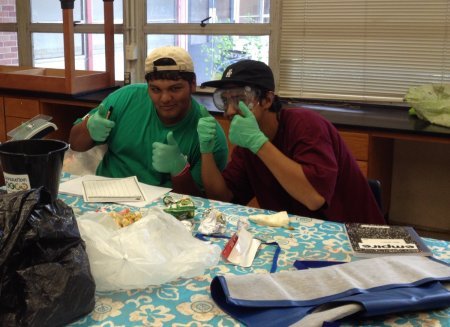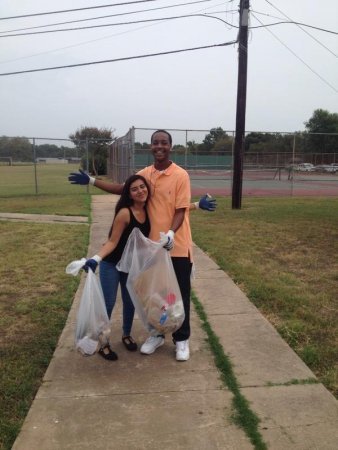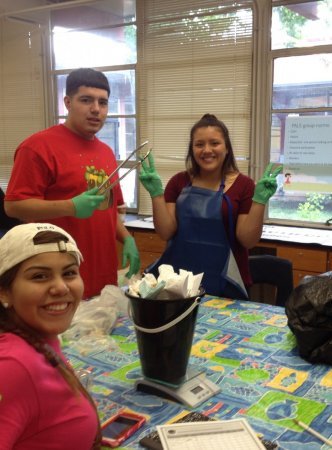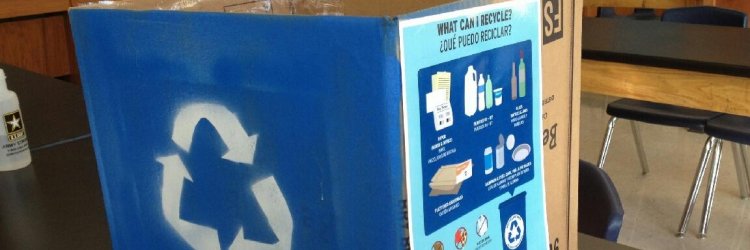Eastside Memorial High School is tucked in the northeast portion of city council district 3. The district, represented by Council Member Renteria, is currently in fourth place in the Austin Recycles Games. The challenge is a four-month competition initiated by Austin Resource Recovery as a way of increasing residential recycling rates and helping residents understand what is and is not recyclable in the city.
Education is a key component to proper recycling, and we sat down with Amanda Mortl Walker, the environmental systems teacher at Eastside Memorial High School to find out what the students there are doing to help District 3 win the Austin Recycles Games, help their families increase their recycling rates, and move the city closer to its zero-waste goal.

Q: What are the current recycling practices at Eastside Memorial?
A: Like at all schools within AISD, Texas Disposal Systems (TDS) picks up landfill and single- stream recycling from the school.
I knew that although the bins were in place, we weren’t doing a great job recycling properly. It wasn’t just the students; it was faculty and community members as well.
We started the year with Keep Austin Beautiful delivering the Generation Zero program, during which our students conducted a school-wide waste audit and learned about what goes into the blue single-stream recycling bins and what doesn’t. The program also encouraged students to take into account the economic aspects of resource management and the benefits of becoming zero waste.
Q: Did you build on that initial programming?
A: From the initial waste audits, we knew that people weren’t sorting items properly. Our audit showed that 82% of what was in our landfill bins was actually recyclable or compostable.
The students conducted an inventory of recycling bins and discovered that not all classrooms had bins. We also heard from teachers and students that some didn’t believe our recyclables were actually making it to TDS, so they didn’t bother sorting.
Most people won’t seek out a recycling container. If all they see is a landfill bin, they will throw their plastic bottles or aluminum cans in there. You have to place landfill and recycling bins next to each other in order to promote proper recycling.
Q: Recycling bins are expensive. How did you make sure that every classroom has them?
A: We upcycled! The Keep Austin Beautiful Green Teens club spray-painted old Xerox boxes and stenciled a recycling symbol on them. This was a great low-cost solution to a very expensive problem.
Also, we are very grateful that Madelyn Morgan and Aiden Cohen from Austin Resource Recovery helped us assess our school’s material flow. They donated a few bins to us as part of that assessment.

Q: What have you and your students done to promote recycling on campus?
A: Mr. Moldenhouer’s Construction Tech students are building 3D display boards, which we will put up around the campus to remind the school community what is and is not recyclable.
Ms. Turner’s Occupational Prep students are picking up the recycling in classrooms and putting it in our recycling dumpster. This helps the custodians not get overwhelmed and the students’ presence reminds us that our recycling really does get recycled!
The students in my Environmental Systems classes went into classrooms and offered bilingual instruction explaining the benefits of recycling and the appropriate items. We are also working on forming an eco-action team. The students on the team will adopt a teacher and hold them accountable for proper recycling in their classrooms. The Green Teens are working on a telenovela video about recycling. It will be screened at assemblies and in advisory periods so that it reaches all of the students and faculty.
Q: What would your advice be to other schools who are considering expanding their recycling efforts?
A: First of all, know what is recyclable in your city. Every city’s recycling is different, and it is important to complete an audit that reflects local recycling practices. When auditing make sure that you have the most current information. Austin has a really handy online tool called “What do I do with…”.
Second, hanging posters doesn’t have a lot of impact. Design an active engagement campaign, which incorporates signage, education, and proper bin placement.
Third, measure your progress. Measurements make the process tangible and gives students a target for achieving the goal. Our goal at Eastside Memorial is to cut the 82% rate of contamination in half by the end of the school-year.
Finally, trust the process. It takes time to properly educate students and faculty. I’m not going to quit. I’ll be here next year doing the same thing and working towards zero-waste.









